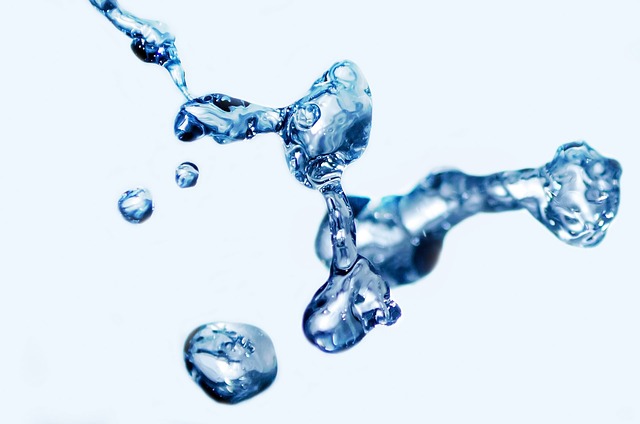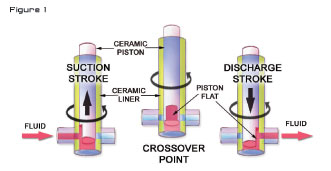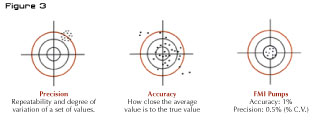From R&D applications in the laboratory to small scale pilot plants, a broad array of low flow and micro-fluidic applications rely on precision dispensing or chemical metering of fluids. But, as diverse as the applications, so are the variety of fluids, their chemical and physical characteristics, as well as the specific application parameters. For the purpose of this article, we will designate low flows as those below 1 liter per minute (L/m) all the way down to just a few milliliters per minute (mL/m). Micro-volume flows range from microliters per minute (uL/min) up to a few mL/min.
In addition to low flow chemical metering process applications, such as pilot plants, there are an increasing number of low flow applications emerging as more and more industries use chemicals available in ultra-high concentrations. It could then be concluded that fluid control components, including pumps, need to have the flexibility to handle many different fluids and applications with accuracy and precision, even at what is considered extremely low flow rates.
CeramPump® Valveless Piston Pump Technology from Fluid Metering, Inc. (FMI) has been proven to be an extremely accurate, yet versatile method for low volume and micro-fluidic chemical metering in a broad range of process, production and OEM instrumentation.
LABORATORY SCALE CHEMICAL METERING
Pilot plants, test stands, and bench-top systems comprise the majority of low flow chemical metering applications. These small scale chemical processing systems are the bridge between R&D process design and full scale production and are used in a broad spectrum of process industries. They generate vital information, which will be incorporated into the design of full-scale process and production facilities. Not only do Pilot Plants reduce the financial risk associated with building larger facilities, but they also test process feasibility and accommodate process refinement. Chemical, petroleum, pharmaceutical, power generation, waste treatment facilities, mining operations, and food processing are just a few examples of industries which utilize small scale systems to test, evaluate, and refine process concepts and designs before moving to full scale process plants.
Chemical feed systems used in pilot plants are scaled down as well, and as a result need to accommodate much lower flow rates than their full process counterparts at an increased accuracy. In addition, because very often process parameters are undefined, the chemical feed pumps used in small scale systems need to handle a broad range of fluid chemical properties, including varying pH, viscosities, pressures, and temperatures, all changing while maintaining an accurate flow rate. Therefore, the metering pump technology used for pilot plant and lab scale processes must accurately meter fluid independent of these variables.
Fluid Metering’s CeramPump® valveless, ceramic metering pumps have proven to be ideal for pilot plant applications primarily due to the pump’s sapphire-hard ceramic internal components. These ceramic internals are both chemically inert and wear resistant. Dimensionally stable ceramic components also eliminate accuracy drift typical of pumping systems that rely on elastomers, (flexible tubing and diaphragms), to move fluid through the pump. Fluid Metering pumps’ unique valveless rotating and reciprocation piston design also eliminates the need for check valves, which can clog, leak or fail over time.
THE CHALLENGES OF METERING CONCENTRATED CHEMICALS
Depending on the industry and the specific application, there are several reasons why highly concentrated chemicals are being used more frequently. For example, in agriculture, precision placement fertilization is an alternative to broadcast spraying to increase effectiveness, as well as reduce the overall environmental impact of residual chemicals in the soil.
For pesticide and mosquito spraying, the cost of transporting and storing large volumes of dilute malathion is significantly higher than shipping small concentrated volumes and diluting them on-site. This is also true for water treatment disinfectant chemicals like sodium hypochlorite, as well as industrial cleaning chemicals such as those used in automatic car wash equipment. In most cases, users of the dilute chemicals found that they were basically paying to ship and store large drums of chemicals that consisted mostly of water.
Other examples of low flow process metering of concentrated chemicals for power generation include metering of bromine for algae control in cooling towers, injecting hydrazine into boiler feed lines for corrosion control, and more recently, a number of fuel cell fluidic applications.
However, metering chemicals at high concentrations has many challenges. As the concentration increases, chemical feed rates significantly decrease. At these low flows, metering precision, and long-term accuracy become more difficult to achieve. Higher concentrations typically have increased corrosive properties as well. The CeramPump® from Fluid Metering, Inc. having chemically inert, sapphire-hard ceramic internals can accommodate all of these application challenges.
MICRO-VOLUME FLUID CONTROL FOR ANALYTICAL INSTRUMENTATION
In addition to the applications mentioned above, The FMI CeramPump® is used in a broad array of analytical applications in chemical process industries (CPI), power generation, pharmaceutical testing, water and wastewater, food manufacturing and environmental monitoring, just to name a few.
FMI CeramPump® Basics
The CeramPump® is a low volume piston pump, manufactured by Fluid Metering, Inc., which uses one moving part to accomplish both the pumping and valving functions thereby eliminate check valves which are present in all other reciprocating (syringe, diaphragm, bellows, piston) designs. The CeramPump® uses a unique rotating and reciprocating ceramic piston, moving within a precision mated ceramic liner to accurately pump fluid in one direction without allowing any backflow. The reciprocation action of the piston acts very similar to a standard piston pump. As the piston moves back, it draws fluid into the pump chamber. As it moves forward, fluid is pushed out of the pump.
However, what is truly unique is that in addition to reciprocating, the piston also simultaneously and continuously rotates in one direction. The piston is designed with a flat cut into the end closest to the inlet and outlet port (see figure 1). As the piston rotates, the flat is alternately aligned with the inlet and outlet port, essentially functioning as a valve. At no time is the inlet and outlet ports interconnected, and therefore the need for check valves is eliminated. One complete synchronous rotation and reciprocation is required for each suction and discharge cycle as shown in figure 1.
Easy Adjustment of Flow Rate and Dispense Volume
The piston displacement (or volume pumped per stroke) is variable and controlled by the angle of the pump head to the drive. When the pump angle is zero, the pump head is in straight alignment with the drive, the flow is zero. In this situation, there is no reciprocation and the piston is only rotating. As the angle of the pump head increases above zero in either direction with respect to the drive, the piston reciprocates, and fluid is moved through the pump (see figure 2). The greater the angle, the greater the displacement per cycle (also known as stroke). Adjustment is infinite between zero and 100 percent and a flow rate indicator provides for accurate and simple linear calibration. The pump is designed so that at any angle and flow rate, the piston always bottoms for maximum bubble clearance. This is especially important at very small dispenses and flow rates, as the presence of even a minute bubble will significantly affect accuracy.

KEY FEATURE SUMMARY
Valveless Design
The valveless feature of the CeramPump® design is its most significant feature. There are typically four check valves present in diaphragm, bellows, and traditional piston pumps. Even during normal operation, these will wear over time and not seal properly allowing backflow. As a result, accuracy will drift, and minimally the pumps will need periodic recalibration. Eventually, the check valves need to be serviced.
Ceramic Internals
The CeramPump® uses sapphire-hard ceramics for both the piston and mated liner. These components are dimensionally stable in that they will not change shape or dimension over time. Therefore, the pumping chamber remains stable for millions of dispenses without downtime or recalibration.
Accuracy and Precision
Consistency in dispensing can be measured by monitoring both the accuracy and precision of the dispenses. Accuracy is a comparison of the average value of the dispense volume compared to the desired or target value. Precision is the range or degree of variation from dispense to dispense. FMI’s CeramPump® will maintain an accuracy better than 1 percent with repeatability better than 0.5 percent (see figures 3 and 4).
Examples of the versatility of FMI’s Valveless CeramPump® chemical metering applications:
- Blending performance additives to diesel and home heating oil on-site
- A sampling of stack gases for environmental air quality monitoring
- Injecting hydrazine into boiler feed lines for corrosion resistance
- Enhancing dairy products with vitamins and other nutrients
- Chemical feed in a broad array of CPI industries including the manufacture of paints, pigments, plastics, specialty papers, adhesives, foundry and metal stamping products, electronics and semiconductor components.
- Micro-dispensing of the liquid crystal in the manufacture of LCD displays
- Dispensing micro-volumes of a conductive fluid (ferrofluid) for the manufacture of audio speakers, headphones, and earbuds.
- Dispensing of potassium hydroxide (KOH) electrolytes in the manufacturing of button cell batteries.
- Metering concentrated hypochlorite for municipal drinking water disinfection
- Micro-fluidic control of samples, reagents and wash chemicals used in medical diagnostic instrumentation, as well as dialysate recirculation in hemodialysis equipment.
- Injecting tracer dyes into streams and groundwater for environmental flow studies.
- Metering and injection of acids and solvents used in hydrometallurgy mining to extract uranium and other ores.
- Agricultural spraying of concentrated nutrients
- Injection of concentrated malathion for mosquito spraying systems
CONCLUSION
For over fifty years, from microliters per dispense to liters/min flow, FMI’s CeramPump® metering pumps have provided long-term, drift-free accuracy in a broad range of applications and industries. The valveless design, having only one moving part made of sapphire-hard ceramics, will maintain a drift-free accuracy of better than 1 percent for millions of maintenance-free cycles, without the need for recalibration. These features make the CeramPump® ideal for low and micro-volume process applications. In addition, long-term drift-free accuracy makes the CeramPump® metering pump especially suited for applications in remote locations (environmental monitoring and hydrogen fuel cells used to power remote cell phone towers). FMI CeramPump® chemical metering pumps are available in a variety of configurations ranging from simple lab pumps to complete programmable metering and dispensing systems, as well as many compact OEM designs for medical, analytical, and process instrumentation.
______________________________________________________________________
ABOUT THE AUTHORS
Christopher S. Johnson is the global engineering manager for centrifugal pumps in Xylem Applied Water Systems in the commercial building and HVAC business unit, while also supporting the other business units with crossover products. He has held leadership roles in sales, application engineering, product management, global sourcing, global product development, and engineering.
Herb Werner has been the marketing manager for Fluid Metering, Inc. for nineteen years with over thirty-five years fluid control experience in chemical process, water treatment, medical and analytical instrumentation, pharmaceutical, and semiconductor industries. He has a B.S in Environmental Biology and is an active member of ISA, AWWA, and WEF societies.
_____________________________________________________________________
MODERN PUMPING TODAY, February 2014
Did you enjoy this article?
Subscribe to the FREE Digital Edition of Modern Pumping Today Magazine!





